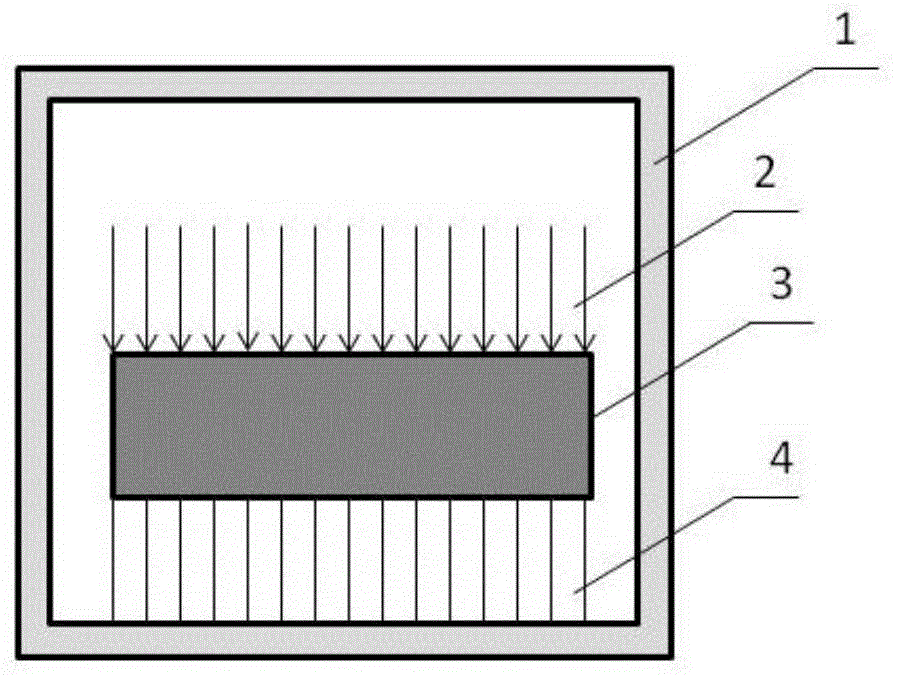Preparation method for composite polymer film with high thermal conductivity
A composite polymer and polymer thin film technology, applied in the field of thermally conductive materials, can solve the problems of low thermal conductivity of polymer nanocomposites, inability to meet ultra-high density heat dissipation requirements, high contact thermal resistance, etc., and achieve low production cost and thermal conductivity. High conductivity, the effect of improving thermal conductivity
- Summary
- Abstract
- Description
- Claims
- Application Information
AI Technical Summary
Benefits of technology
Problems solved by technology
Method used
Image
Examples
Embodiment 1
[0022] With reference to accompanying drawing, a kind of preparation method of high thermal conductivity composite polyethylene film comprises the following steps:
[0023] 1) Mix high thermal conductivity particles and polymer particles at a mass ratio of 1:10, and use an injection molding process to obtain the first polymer film 3 containing high thermal conductivity particles or fibers, the high thermal conductivity particles are Ag particles, and the polymer particles are polyethylene PE;
[0024] 2) Place the first polymer film 3 prepared in step 1) on the porous template 4, then put the porous template 4 into the vacuum heating box 1, and the vacuum heating box 1 keeps 130 0 constant temperature;
[0025] 3) After the first polymer film 3 is melted, the porous template 4 is filled under the joint action of capillary force and the external pressure provided by the pressurizing device 2 to form a second polymer film;
[0026] 4) After 30 minutes, the obtained porous templat
Embodiment 2
[0032] With reference to accompanying drawing, a kind of preparation method of high thermal conductivity composite polyethylene film comprises the following steps:
[0033] 1) Mix high thermal conductivity fibers and polymer particles in a ratio of 1:5, and use a compression molding process to obtain the first polymer film 3 containing high thermal conductivity particles or fibers, the high thermal conductivity fibers are carbon fibers, and the polymer particles are polyethylene PE;
[0034] 2) Place the first polymer film 3 prepared in step 1) on the porous template 4, then put the porous template 4 into the vacuum heating box 1, and keep the vacuum heating box 1 at a constant temperature of 150°C;
[0035] 3) After the first polymer film 3 is melted, the porous template 4 is filled under the joint action of capillary force and the external pressure provided by the pressurizing device 2 to form a second polymer film;
[0036] 4) After 60 minutes, the obtained porous template 4 c
Embodiment 3
[0042] With reference to accompanying drawing, a kind of preparation method of high thermal conductivity composite polypropylene film comprises the following steps:
[0043] 1) Mix high thermal conductivity fibers and polymer particles in a mass ratio of 1:1, and use an injection molding process to obtain the first polymer film 3 containing high thermal conductivity particles or fibers. The high thermal conductivity fibers are AIN whiskers, and the polymer particles are Polypropylene PP;
[0044] 2) Place the first polymer film 3 prepared in step 1) on the porous template 4, then put the porous template 4 into the vacuum heating box 1, and keep the vacuum heating box 1 at a constant temperature of 180°C;
[0045] 3) After the first polymer film 3 is melted, the porous template 4 is filled under the joint action of capillary force and the external pressure provided by the pressurizing device 2 to form a second polymer film;
[0046] 4) After 90 minutes, the obtained porous templa
PUM
| Property | Measurement | Unit |
|---|---|---|
| Thermal conductivity | aaaaa | aaaaa |
| Thermal conductivity | aaaaa | aaaaa |
| Thermal conductivity | aaaaa | aaaaa |
Abstract
Description
Claims
Application Information
 Login to view more
Login to view more - R&D Engineer
- R&D Manager
- IP Professional
- Industry Leading Data Capabilities
- Powerful AI technology
- Patent DNA Extraction
Browse by: Latest US Patents, China's latest patents, Technical Efficacy Thesaurus, Application Domain, Technology Topic.
© 2024 PatSnap. All rights reserved.Legal|Privacy policy|Modern Slavery Act Transparency Statement|Sitemap

